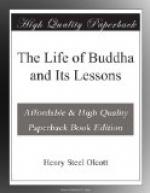Why need I use the few moments at my disposal to marshal before you the various personages of whom these fables have been written? Let it suffice to recall the interesting fact to your notice, and invite you to compare the respective biographies of the Brahmanical Krshna, the Persian Zoroaster, the Egyptian Hermes, the Indian Gautama, and the canonical, especially the apocryphal, Jesus. Taking Krshna or Zoroaster, as you please, as the most ancient, and coming down the chronological line of descent, you will find them all made after the same pattern. The real personage is all covered up and concealed under the embroidered veils of the romancer and the enthusiastic historiographer. What is surprising to me is that this tendency to exaggeration and hyperbole is not more commonly allowed for by those who in our days attempt to discuss and compare religions. We are constantly and painfully reminded that the prejudice of inimical critics, on the one hand, and the furious bigotry of devotees, on the other, blind men to fact and probability, and lead to gross injustice. Let me take as an example the mythical biographies of Jesus. At the time when the Council of Nicea was convened for settling the quarrels of certain bishops, and for the purpose of examining into the canonicity of the three hundred more or less apocryphal gospels that were being read in the Christian churches as inspired writings, the history of the life of Christ had reached the height of absurd myth. We may see some specimens in the extant books of the apocryphal New Testament, but most of them are now lost. What have been retained in the present Canon may doubtless be regarded as the least objectionable. And yet we must not hastily adopt even this conclusion, for you know that Sabina, Bishop of Heracha, himself speaking of the Council of Nicea, affirms that “except Constantine and Sabinus, Bishop of Pamphilus, these bishops were a set of illiterate, simple creatures that understood nothing”; which is as though he had said they were a pack of fools. And Pappus, in his Synodicon to that Council of Nicea, lets us into the secret that the Canon was not decided by a careful comparison of several gospels before them, but by a lottery. Having, he tells us, “promiscuously put all the books that were referred to the Council for determination under a Communion table in a church, they (the bishops) besought the Lord that the inspired writings might get up on the table, while the spurious writings remained underneath, and it happened accordingly”.
But letting all this pass and looking only to what is contained in the present Canon, we see the same tendency to compel all nature to attest the divinity of the writer’s hero. At the nativity a star leaves its orbit and leads the Persian astrologers to the divine child, and angels come and converse with shepherds, and a whole train of like celestial phenomena occurs at various stages of his earthly career,




